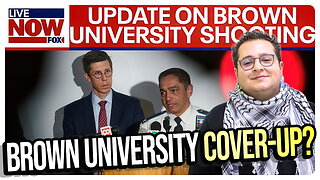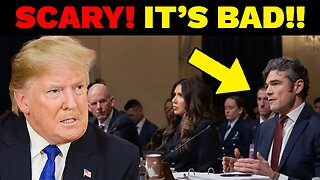Premium Only Content

Episode 3138: Archbishop Bugnini and the Consilium: Architect of a Liturgical Revolution - Morning Episode
Nightly Zoom Coordinates for Rosary:
Meeting ID: 865 8978 0399
Passcode: Wjjv4960!
Speak Lord for your Servant is Listening
Book Recommendation of the Day
Maria Goretti: In Garments All Red
Author: Rev. Godfrey Poage, C.P.
Publisher: TAN Books
Description:
This is one of the most well-known and widely recommended biographies of St. Maria Goretti. It gives a moving and detailed account of her short life, her heroic defense of purity, her martyrdom, and the extraordinary forgiveness she showed her attacker. It also includes the story of Alessandro Serenelli's conversion. Written in a traditional, reverent tone.
Today we examine
“Bugnini and the Consilium: Architect of a Liturgical Revolution”
This episode examining Archbishop Annibale Bugnini and the radical reengineering of the Roman Rite under the Consilium following Vatican II.
I never heard of Bugnini until Pope Benedict released Summorum Pontificum and I asked a Priest (Fr Vogt) and the Robert Moynihan, Ph.D. Founder and Editor in Chief of “Inside the Vatican” to give a talk on the encyclical. It was Robert Moynihan that brought in a book on Bugnini and I asked myself why is it I never heard of Archbishop Annibale Bugnini and now I ask myself why is it that I never heard of
Summorum Pontificum
Issued by: Pope Benedict XVI
Date: July 7, 2007
Effective: September 14, 2007 (Feast of the Exaltation of the Holy Cross)
Type: Apostolic Letter motu proprio (on his own initiative)
Purpose:
To broaden the availability of the Traditional Latin Mass (also known as the Tridentine Mass or the 1962 Roman Missal) and clarify that it was never abrogated after Vatican II.
Key Highlights:
1. Two Forms of the Roman Rite:
• Ordinary Form: The Mass of Paul VI (Novus Ordo, promulgated in 1970).
• Extraordinary Form: The Mass of John XXIII (1962 Missal, pre-Vatican II form).
2. Permission to Use the 1962 Missal:
• Any priest of the Latin Rite may privately celebrate the Traditional Latin Mass without requiring permission from the bishop.
• Faithful may attend these Masses freely.
3. Public Celebrations and Parish Requests:
• Where a group of faithful is attached to the Traditional Latin Mass, the pastor should willingly accommodate them.
• The bishop should ensure that qualified priests are available to meet the needs of these faithful.
4. Sacraments in the Old Form:
• Permission was also extended to celebrate other sacraments (Baptism, Marriage, Confession, Anointing of the Sick) according to the 1962 Rituale Romanum.
5. Seminaries:
• Seminaries should offer training in Latin and the Extraordinary Form so that priests can celebrate it properly.
Key Message:
Pope Benedict emphasized that there is no rupture between the pre-Vatican II and post-Vatican II liturgical forms. He hoped this would promote reconciliation within the Church, especially with those attached to the older liturgical tradition (e.g., the Society of St. Pius X).
Significance:
• Seen as a major restoration and legitimization of the Traditional Latin Mass.
• Strengthened the continuity and richness of the Church’s liturgical heritage.
• It was later restricted by Pope Francis in his 2021 document Traditionis Custodes.
Where the sacred treasures of the Church are defended against the spirit of the age.
4th in our series on the Liturgical Revolution, and we turn now to the man most responsible for transforming the liturgy from a heavenly sacrifice into a horizontal celebration: Archbishop Annibale Bugnini.
From the shadows of Vatican II to the fabrication of the Novus Ordo Missae, Bugnini and the Consilium he led carried out one of the most sweeping and disruptive revolutions in the history of the Church under the guise of renewal.
PART I: WHO WAS ANNIBALE BUGNINI?
Early Background:
• Born June 14, 1912 in Civitella del Lazio, Italy.
• Ordained in 1936, he became a professor of liturgy and theology.
• In 1948, appointed as Secretary to the Commission for Liturgical Reform under Pius XII.
o He was instrumental in drafting Mediator Dei a document he would later twist to his advantage.
• By 1960, he had already begun writing about reforming the Roman Rite from the ground up.
Rise to Power:
• In 1964, Bugnini was appointed Secretary of the Consilium ad exsequendam Constitutionem de Sacra Liturgia the Vatican body created to implement Sacrosanctum Concilium.
• He soon became the most powerful liturgical figure in the Church, guiding every aspect of the reform.
Dom Alcuin Reid wrote:
“The implementation of Sacrosanctum Concilium was entrusted to a man who had already devised his own vision of a reformed liturgy before the Council even began.”
PART II: WHAT WAS THE CONSILIUM?
Foundation:
• Established by Pope Paul VI in 1964.
• It was a “super-commission” meant to reform the liturgy.
• Separate from the Congregation for Rites, meaning it operated with little traditional oversight.
Membership:
• Headed by Cardinal Giacomo Lercaro (President).
• Bugnini as Secretary and real mastermind.
• Included 50 bishops and over 200 consultants mostly progressive liturgists.
• Advisors included:
o Fr. Josef Jungmann: historical critic of the Roman Rite.
o Dom Cipriano Vagaggini: promoted new Eucharistic prayers.
o Fr. Louis Bouyer – a convert who would later regret his involvement.
Bouyer said:
“It is impossible to imagine anything worse than what happened. I was disgusted. Bugnini was a megalomaniac without scruples.”
PART III: THE MANDATE: TWISTING SACROSANCTUM CONCILIUM
The Deceptive Approach:
Bugnini claimed fidelity to Sacrosanctum Concilium, but in truth, used its vague language as license to remake the Roman Rite.
Example 1: Latin vs. Vernacular
• SC 36 says Latin is to be preserved.
• Bugnini implemented near-total vernacularization within a few years.
• This contradicted even the wishes of John XXIII, who issued Veterum Sapientia (1962), declaring Latin essential to unity and sacredness.
Example 2: Simplicity of Rites
• SC 34 called for “noble simplicity.”
• Bugnini removed or rewrote thousands of years of liturgical content, such as:
o The Offertory prayers
o The Last Gospel
o Multiple signs of the Cross, genuflections, and silent prayers
Pope Pius XII had warned:
“One would be straying from the path of truth if he regarded all ancient rites as always better.”
But Bugnini’s goal wasn’t just reform it was revolution.
PART IV: BUILDING A NEW MASS: THE NOVUS ORDO MISSAE
Timeline:
• 1965: Transitional Missal issued minor changes from 1962.
• 1967: “Normative Mass” introduced experimentally.
• 1969: Missale Romanum of Paul VI promulgated the Novus Ordo.
Changes Introduced:
Structure:
• Traditional: Offertory, Canon, Communion, with prayers flowing from Calvary.
• Novus Ordo: Divided into “Liturgy of the Word” and “Liturgy of the Eucharist” modeled on Protestant structures.
Eucharistic Prayers:
• Added three new “Canons”.
• Eucharistic Prayer II created in a few hours by Dom Vagaggini and Bugnini.
o It lacks mention of sacrifice, Real Presence, or priesthood.
Offertory:
• Prayers referring to sacrifice, sin, and redemption removed.
• Replaced with Jewish blessing formulas over bread and wine.
Orientation:
• Traditional: Priest facing God (ad orientem) with the people.
• Novus Ordo: Priest faces people, turning the Mass into a dialogue.
Language:
• Latin virtually abolished, despite centuries of papal decrees.
• Translations (like “for all” instead of pro multis) caused doctrinal confusion.
PART V: TESTIMONIES AND WARNINGS
1. Cardinal Alfredo Ottaviani: The Ottaviani Intervention (1969)
“The Novus Ordo Missae… represents, both as a whole and in its details, a striking departure from the Catholic theology of the Mass as it was formulated at the Council of Trent.”
This letter, signed by Ottaviani and Bacci, was submitted directly to Pope Paul VI who chose to ignore it.
2. Archbishop Marcel Lefebvre
“They have rebuilt the Mass to resemble a Protestant service. It is no longer the Holy Sacrifice, but a meal of the community.”
Lefebvre was present at Vatican II and saw firsthand how Bugnini manipulated the post-conciliar process.
3. Cardinal John Heenan (UK)
After witnessing a demonstration of the reformed Mass in 1967:
“If this were celebrated in England, it would drive people away. It looks like a parody of a Catholic Mass.”
PART VI: THE MYSTERIOUS FALL OF BUGNINI
In 1975, Bugnini was suddenly removed from his post without public explanation.
Alleged Reasons:
• A dossier was reportedly given to Pope Paul VI accusing Bugnini of being a Freemason.
• Paul VI exiled him to Iran as Apostolic Nuncio far from Rome, and never recalled to liturgical work.
According to Michael Davies, the dossier came from a trusted source within the Curia and contained serious evidence.
Whether confirmed or not, the swiftness and silence of Bugnini’s removal speaks volumes.
PART VII: LEGACY AND DESTRUCTION
Though Bugnini was exiled, his reforms remained:
• The Novus Ordo Missae is still the “ordinary form” of the Roman Rite.
• The loss of reverence, mystery, and doctrinal clarity has led to:
o Decline in belief in the Real Presence
o Drop in vocations
o Rise in liturgical abuse
o Confusion among the faithful
Bugnini's Own Words:
“We must strip from our Catholic prayers and from the Catholic liturgy everything which can be the shadow of a stumbling block for our separated brethren.”
This is not the voice of Tradition. It is the voice of ecumenical compromise.
CONCLUSION: FROM THE COUNCIL TO THE COLLAPSE
Annibale Bugnini is not remembered as a liturgical renewer but as the mastermind behind a rupture.
He abused the authority of Vatican II, manipulated committees, and implemented the most radical revision of the Roman Rite in Catholic history without mandate, precedent, or fidelity.
“The smoke of Satan has entered the Church.” – Pope Paul VI (1972)
Many believe that “smoke” entered through the liturgical revolution that Bugnini orchestrated.
Epistle – Colossians 1:1–4 (St. Andrew’s Missal, likely Reading)
“Paul, an apostle of Jesus Christ by the will of God, and Timothy the brother: To the faithful brethren in Christ at Colossae: Grace to you and peace from God our Father and the Lord Jesus Christ. We give thanks to God, the Father of our Lord Jesus Christ, praying always for you, since we have heard of your faith in Christ Jesus, and of your love toward all the saints.”
Reflection – Faith Rooted in Love
Saint Paul greets the Colossians with a reminder of their twofold Christian identity: faith in Christ and love for the saints. These are the twin pillars of authentic Catholic living firm doctrinal belief and fraternal charity.
In our age, faith is often diluted intellectual assent without heartfelt practice. Love is often neutered kindness without truth. The Colossians model the integrated life we tirelessly pursue. We, too, can pray: “Lord, deepen my faith; enliven my charity.”
Gospel – Luke 10:23–37
“And turning to the disciples, Jesus said, ‘Blessed are the eyes, which see the things that you see. For I say to you that many prophets and kings have desired to see the things which you see and have not seen them... But a certain lawyer stood up and tempted Him, saying, ‘Master, what shall I do to inherit eternal life?’ And He said to him: ‘What is written in the law? How readest thou?’ He answering said: ‘Thou shalt love the Lord thy God with all thy heart… and thy neighbour as thyself.’ And He said unto him: ‘Thou hast answered right: this do, and thou shalt live.’”
Reflection – See, Know, and Do
Our Lord praises His disciples as privileged witnesses of Truth, yet quickly brings the focus back to action. True faith isn’t merely theoretical it manifests in love of God and neighbor.
The parable of the Good Samaritan isn’t just about charity it’s about crossing barriers, personal sacrifice, and mercy that costs something. The Christian life is not passive; it’s demanding. But Jesus shows that the path to eternal life is found in ordinary encounters helping someone in need, showing compassion, living mercy.
St. Maria Goretti (1890–1902) was an Italian virgin-martyr and one of the youngest canonized saints in the Catholic Church. Born on October 16, 1890, in Corinaldo, Italy, Maria was the third of seven children in a poor but devout farming family. Her father died of malaria when she was nine, forcing the family into deeper poverty and hardship.
Despite her young age, Maria took on many household responsibilities and was known for her deep faith, purity, and devotion to Our Lady. On July 5, 1902, at the age of eleven, she was attacked by a nineteen-year-old neighbor, Alessandro Serenelli, who attempted to rape her. Maria resisted, crying out that what he wanted was a sin and that it would offend God. In anger, Alessandro stabbed her 14 times.
She was taken to the hospital and lived for about 24 hours. During that time, she forgave her attacker, saying, "Yes, for the love of Jesus I forgive him... and I want him to be with me in Paradise." She died on July 6, 1902.
Years later, Alessandro repented deeply, after a dream in which Maria appeared to him offering him lilies that turned to light. He eventually became a lay brother in a Capuchin monastery and was present at her canonization in 1950 by Pope Pius XII, who proclaimed her a martyr of purity and a model for youth.
St. Maria Goretti is the patron saint of youth, young women, purity, and victims of rape. Her feast day is celebrated on July 6.
Quotes & Themes
• Colossians 1:3–4 – “We give thanks… praying always for you… of your faith and love.”
→ True faith always blossoms in prayer and thanksgiving.
• Luke 10:27 – “Thou hast answered right... this do, and thou shalt live.”
→ Faith without works leads nowhere; works without faith build nothing.
• St. Veronica Giuliani: “To love with purity is to let your every action flow from God’s love.”
• Themes for Meditation:
1. Faith & Charity are inseparable.
2. Privileged knowledge demands practical commitment.
3. Little crosses lead to great sanctity.
Conclusionary Prayer
Let us pray.
O Lord Jesus Christ, who didst bless Thy disciples with truth and vision, deepen within us a faith that sees beyond earthly things, and a love that acts upon what we see.
Through the intercession of St. Maria Goretti, grant us humble hearts that, rooted in prayer and fidelity, bear the fragrance of holiness in our families, parishes, and communities.
May we, like the Good Samaritan, cross distance and inconvenience to bring Your mercy to the lowly and the broken knowing that in loving them, we love You.
We ask this through Christ our Lord. Amen.
Our Lady, Mediatrix of All Graces, guide us.
Sacred Heart of Jesus, inflame us with love for You and for neighbor.
-
 1:11:19
1:11:19
vivafrei
3 hours agoCandace Owens' Backtracks? Brown University Cover-Up? Bongino Leaves! Pfizer Makes LEGAL ADMISSIONS?
109K47 -
![[Ep 813] LIVE from Rumble Set at AmFest 2025 | Guests Vem, Midnight, & Kevin Smith](https://1a-1791.com/video/fwe2/31/s8/1/4/F/c/J/4FcJz.0kob-small-Ep-813-LIVE-from-Rumble-Set.jpg) 56:22
56:22
The Nunn Report - w/ Dan Nunn
3 hours ago[Ep 813] LIVE from Rumble Set at AmFest 2025 | Guests Vem, Midnight, & Kevin Smith
24.7K3 -
 29:58
29:58
Stephen Gardner
4 hours ago🔥IT'S BAD! NEW report just DROPPED!
30.5K17 -
 LIVE
LIVE
LFA TV
19 hours agoLIVE & BREAKING NEWS! | THURSDAY 12/18/25
1,224 watching -
 LIVE
LIVE
freecastle
6 hours agoTAKE UP YOUR CROSS- A man’s heart PLANS his way, but the LORD DIRECTS his steps!
81 watching -
 LIVE
LIVE
John Crump Live
1 hour agoChristmas Special
44 watching -
 54:53
54:53
The Quartering
6 hours agoDan Bongino Quits, New Break In Tyler Robinson Case & Brown Shooting!
117K60 -
 2:12:49
2:12:49
Side Scrollers Podcast
6 hours agoTrans Surgeries For Kids CRIMINALIZED + Harassed Target Employee Speaks Out + More | Side Scrollers
82.2K19 -
 1:01:16
1:01:16
Timcast
6 hours agoTrump TROLLS Legacy Media, Announces WARRIOR DIVIDEND, Venezuela Fake Out
203K85 -
 1:04:30
1:04:30
Sean Unpaved
5 hours agoSeahawks Looking For REVENGE Against Rams! | UNPAVED
39.1K1